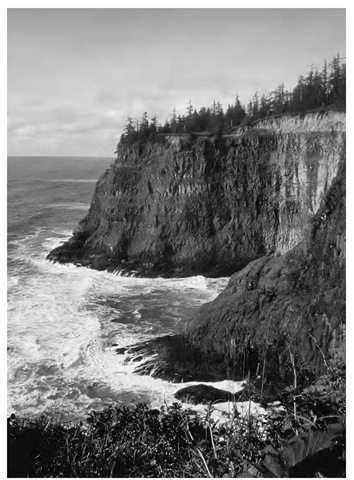OREGON’S AVERAGE ELEVATION is 3,300 ft. (1,006 m.) above sea level, with a range in elevation from sea level along the Pacific Ocean, to the peak of Mt. Hood at 11,239 ft. (3,426 m.). Mountain ranges, including the Coast Range, and the Cascades, divide Oregon. Inland from the Coast Range of mountains is the Willamette Valley, which includes the Willamette River, flowing toward the Columbia River. The Columbia Plateau is northeast of Willamette Valley and west of the Cascades. East of the Cascades is high plateau, and the Great Basin, an area of high desert.
Mountain ranges divide Oregon. West of the Cascades, Oregon’s climate is moderated by the Pacific Ocean.
Oregon’s mountain ranges absorb moisture and precipitation. West of the Cascades, the climate is moderated by the Pacific Ocean, giving cool summers (average summer temperatures below 70 degrees F or 21 degrees C) and mild winters (above freezing even during the coldest months). The Willamette Valley receives almost 48 in. (123 cm.) of rain per year. The Columbia Plateau northeast of Willamette Valley, and west of the Cascades has a mild climate. The Cascades experience below freezing temperatures in the winter months, with heavy snowfall (up to 50 ft. or 15 m.), and snow remains for many months. East of the Cascades and the Great Basin, an area of high desert has dry air and extremes of hot and cold, while receiving less than 10 in. (25 cm.) of rain per year. The highest temperature recorded in the state was 119 degrees F (48 degrees C) on July 29 and August 10 of 1898, and the lowest temperature recorded in the state was minus 54 degrees F (minus 48 degrees C) on February 9 and 10, 1933.
The state supports a population of over 3.5 million people. Forests used for logging cover more than 40 percent of Oregon. The Grand Coulee Dam retains some water from spring runoff for summer use, and supplies hydroelectric energy throughout the west.
IMPACT OF CLIMATE CHANGE
The flood of 1996, caused by a combination of heavy snowstorms followed by warm temperatures and rain, resulted in the overflow of most of Oregon’s waterways. Low-lying areas like Tillamook became lakes. In addition to the weather, logging and road-building may have been contributing factors.
Lumber is a major industry and preservation is a concern. Commercial logging started in the 1800s and has claimed 90 percent of the forests that once grew in the Pacific Northwest, creating checkerboards of clear-cut and uncut forest vulnerable to environmental pressures. More than half the remaining untouched forest areas in Olympic National Forest are slated for cutting during the next 50 years, as is 69 percent of the old growth in Oregon’s Siuslaw National Forest. Trees absorb carbon dioxide (CO2), and as more trees are cut, the less CO2 can be absorbed.
Climate models vary on the amount of temperature increase during the 21st century, from 2.5-10.4 degrees F (1.4-5.8 degrees C). Potential risks include smaller snow pack (average water content of the Northwest snow pack declined by 30 percent between 1950 and the 1990s); rising sea levels between 4-35 in. (10-89 cm.); decreased water supplies; increased risk for wildfires; population displacement; changes in food production (with agriculture improving in cooler climates and decreasing in warmer climates); and changes in rain patterns to downpours, with the potential for flash flooding and health risks of certain infectious diseases from water contamination or disease-carrying vectors such as mosquitoes, ticks, rodents; and heat-related illnesses.
With a predicted decrease in Cascade snow pack, access to fresh water will diminish and affect crops, forests, and potable water supplies, and possibly cause decreased hydroelectric output. Rising sea levels will change the coastline, including beach erosion and land loss, making infrastructure (roads and buildings) vulnerable with the possible displacement of populations. The impact of climate change on agriculture will be mixed; some crops, like potatoes and wine grapes, could be negatively impacted by rising temperatures, decreasing yields. By comparison, the orchard crops will mature more quickly at higher temperatures, with increased quality and market share value. Some areas may need to change crops for those with higher drought resistance and adaptability to a warmer climate.
ADDRESSING HUMAN INDUCED CONTRIBUTIONS TO CLIMATE CHANGE
Based on energy consumption data from Energy Information Agency, Oregon’s total CO2 emissions from fossil fuel combustion in million metric tons for 2004 were 42.50, made up of contributions by source from: commercial, 1.78; industrial, 7.32; residential, 2.58; transportation, 22.80; and electric power, 8.03. In 1997, the state legislature adopted a CO2 emissions performance standard of 675 pounds of CO2 per MWh for electric generating units. Oregon’s Greenhouse Gas reduction target is to stabilize by 2010, fall to 10 percent below 1990 levels by 2029, and fall to 75 percent below 1990 levels by 2050.
Oregon’s governor appointed the Climate Change Integration Group in June of 2006 to develop a climate change strategy for Oregon that provides long-term sustainability. Oregon holds member status with the Western Regional Climate Action Initiative, in which the partners will set an overall regional goal for reducing greenhouse gas emissions. Oregon joined the Climate Registry, a voluntary national initiative to track, verify, and report greenhouse gas emissions, with acceptance of data from state agencies, corporations, and educational institutions beginning in January of 2008.
Portland, Oregon is the base for Earth Share of Oregon, a nonprofit federation of 68 local and national environmental conservation groups for workplace fundraising. Founded in 1989 to provide stable funding sources, Earth Share has raised over $8.5 million. Earth Share supports groups seeking to reduce global warming (through tree planting, recycling, proposing energy policies, monitoring industry practices, preserving natural habitats, and ensuring the availability of clean water).

